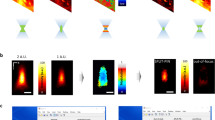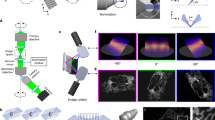Abstract
IN a confocal scanning laser microscope1,2 (CSLM), the detector pinhole is confocal with the illuminated spot on the sample, and rejects light reflected from objects that are not in the focal plane. This results in images that contain only sharp or empty areas, as opposed to non-confocal images which contain sharp and blurry areas, and allows the CSLM to perform optical sectioning. Individual optical sections can be used to produce a true three-dimensional image or can be added together to produce an extended-depth-of-focus image. For biological specimens, the intensity of the reflected-light (or fluorescence) signal decreases with increasing penetration into the sample, and self-shadowing also limits the information in the image. Moreover, many biological specimens are only weak reflectors, but produce transmission images with good contrast. The only confocal transmission images reported previously have used scanning-stage microscopes3,4, although Goldstein5 has reported a confocal scanning-beam micro-scope that should in principle work in transmission. Here we describe a microscope that produces true confocal images in trans-mission, and also forms a reflected-light image from both the top and bottom of the specimen. The optical slices produced in trans-mission do not change in average intensity with depth in the specimen, and as the microscope can also examine the specimen from the bottom in reflected light, loss of data by self-shadowing is minimized. All of the original contrast modes of the CSLM (reflected light, fluorescence, differential phase contrast and so on) are also available using this new microscope.
This is a preview of subscription content, access via your institution
Access options
Subscribe to this journal
Receive 51 print issues and online access
$199.00 per year
only $3.90 per issue
Buy this article
- Purchase on Springer Link
- Instant access to full article PDF
Prices may be subject to local taxes which are calculated during checkout
Similar content being viewed by others
References
Wilson, T. & Sheppard, C. J. R. Theory and Practice of Scanning Optical Microscopy (Academic, London, 1984).
Pawley, J. (ed.) The Handbook of Biological Confocal Microscopy (IMR, Madison, 1989).
Brakenhoff, G. J. J. Microsc. 117, 233–242 (1979).
Dixon, A. E., Damaskinos, S. & Atkinson, M. R. Scanning (in the press).
Goldstein, S. J. Microsc. 153, RP1–RP2 (1989).
Author information
Authors and Affiliations
Rights and permissions
About this article
Cite this article
Dixon, A., Damaskinos, S. & Atkinson, M. A scanning confocal microscope for transmission and reflection imaging. Nature 351, 551–553 (1991). https://doi.org/10.1038/351551a0
Received:
Accepted:
Issue Date:
DOI: https://doi.org/10.1038/351551a0
This article is cited by
-
An acoustofluidic scanning nanoscope using enhanced image stacking and processing
Microsystems & Nanoengineering (2022)
-
Interaction between living cells and polymeric particles: potential application of ionic liquid for evaluating the cellular uptake of biodegradable polymeric particles composed of poly(amino acid)
Polymer Journal (2015)
Comments
By submitting a comment you agree to abide by our Terms and Community Guidelines. If you find something abusive or that does not comply with our terms or guidelines please flag it as inappropriate.



